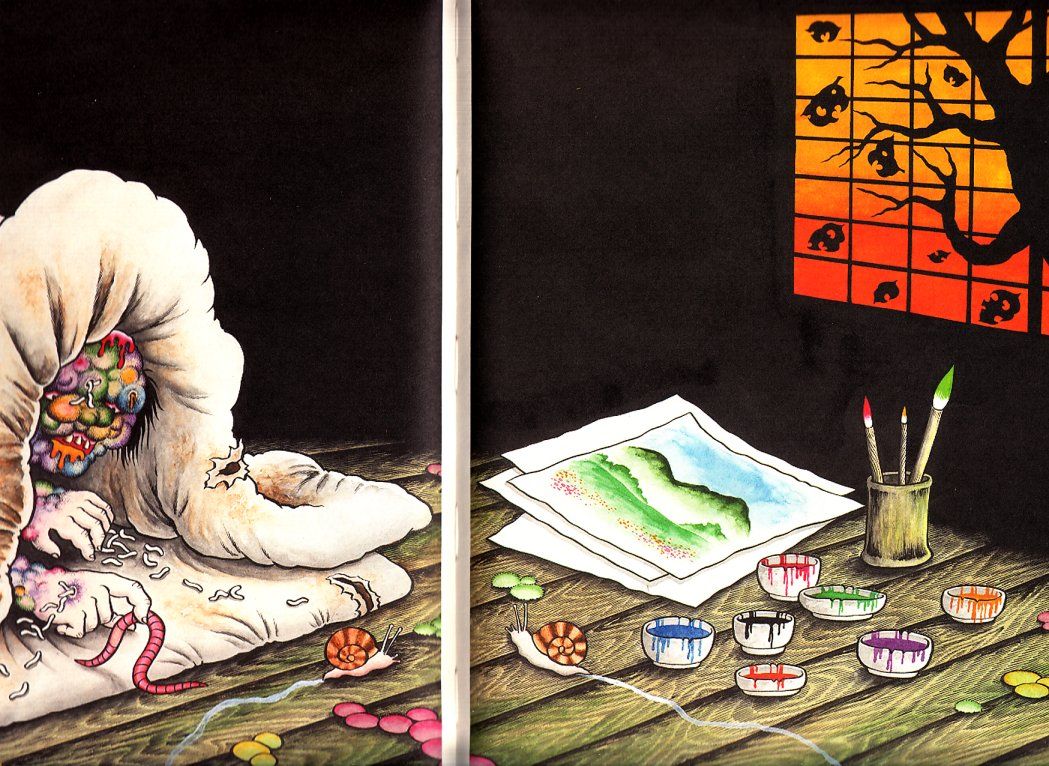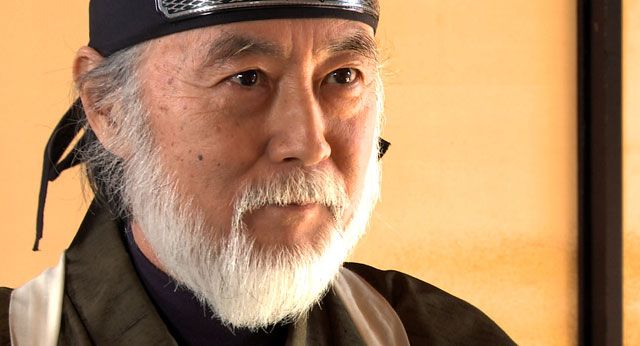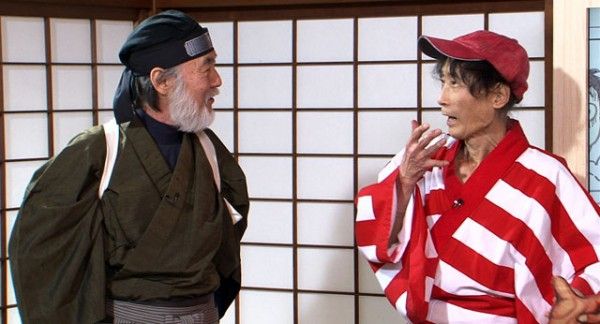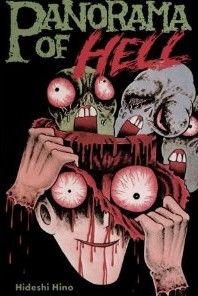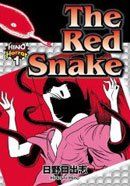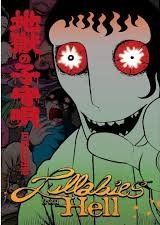Continuing on with my October feature of horror manga artists in English, this week I'm going to be looking at Hideshi Hino. Hino probably has more one-shot volumes than any other manga artist translated into English, thanks to the efforts of DH Publishing. Most of his books are available in a series called "Hino Horror," although there's a few outliers from other publishers that I'll be looking at in this article as well.
Hideshi Hino usually takes very serious author photos.
Though he doesn't have quite the signature style that Kazuo Umezu does. Umezu is the fellow on the right.. Both of these photos are from Same Hat.
Much like Umezu, Hino rose to fame by drawing horror manga for children, mostly one-shots and short stories. Unlike Umezu, he didn't get super-famous for it, and to my knowledge, never drew any multi-volume works. He did draw a couple more mature volumes, but most of his work has been one-volume stories aimed at a younger audience. Most of what's been translated into English (the Hino Horror series from DH Publishing) is from the 80s and 90s, and some of the books are a bit hit-and-miss, but when they're good they're very good. While it may sound a bit off-putting to hear that most of his work is for children, Hino has a particularly unsettling style when it comes to drawing horror manga. Because he honed his skills on stories for children, his stories have a cartoony quality, a lot of round characters with bulging eyes and simplified details, and this tends to make the (sometimes very disturbing) subject matter even more so, since it looks like it was drawn for children. When he wants to, he can include a lot of detail, and there's nothing quite as creepy as a bloated corpse, guts hanging out, drawn in a style meant for children. He's also quite good at setting mood, and some of his favorite settings are blown-out wastelands, garbage dumps, and environments choked with garbage and gore.
The fate of "the artist" is also a favorite of his. The three books I'm going to look at by him are the three best in English, and all three concern a narrator who is telling you his life story, usually an artist that is drawing the story.
Panorama of Hell - 1 volume
I've already talked about Panorama of Hell, but to be honest with you, it's one of my favorite one-shot graphic novels ever, and it deserves another look in the context of this article. Plus, it's easier to start with this book and connect the other two to it. There's an interesting article in The Comics Journal that discusses Hino's state of mind when he drew this story. He was suffering from severe alcoholism and was not at all well. He was seriously considering retiring, and drew this to be his last work published. The result is an absolutely crazy swan song that few could surpass in terms of scary stories. The main character is "the artist," and each of the short chapters looks at a different element of his life. The first chapter introduces us (literally, The Artist is directly addressing the reader) to his Hell Paintings, which he paints with buckets of his own blood. The second introduces his beautiful wife, who works at a bar that serves corpses which have been decapitated down the river of blood nearby. Krazy Boy and Krazy Girl are his two children, who like to collect pieces of dead animals and play in the garbage and offal around his house. From there, "The Artist" begins to tell the story of his family and life, which bears striking similarities to Hino's own family, some members of whom were reportedly yakuza, and his family's flight from Manchuria shortly after he was born. After the whole story is told, the narrator begins to go on a violent rampage in his Hell City of bodies, rot, death, and garbage, and the whole thing takes on a surreal quality at the end that... makes you wonder, to say the least. Hino's art is at its surreal, cartoony best here, with lots of cartoony body parts and dead animals, strange and mysterious women cutting "mouths" into the necks of the decapitated bodies, garbage, blood, and all sorts of other things which we've been desensitized to rendered in cartoony and copious detail. It's an absolutely fantastic book, the best Hino wrote, and there are few like it in comics. Unfortunately, it was released in 1993 and is long out of print. Used copies usually start around $50.
Red Snake - 1 volume
If you have trouble laying hands on a copy of Panorama of Hell, happily, Red Snake is almost the same thing, and is much easier to get ahold of. The main character in this story is a little boy who, again, is directly addressing the reader and telling them about his house and family. Unlike Panorama of Hell, which is set in a Hell World, Red Snake is contained inside one crazy house. One by one, the narrator introduces you to members of his family. For instance, his grandfather has a huge, disgusting tumor hanging off the side of his face that is nearly the size of his head. Every morning, the narrator's mother massages eggs into the tumor, then steps on it until it pops and pus shoots out the end. Everyone in the house has similar, disgusting and very creepy jobs. The titular red snakes haunt the narrator, and eventually, the whole surreal horror unreality of things collapses in on itself. The story was drawn later, and lacks some of the dire impact of Panorama of Hell, but Red Snake manages to be a bit more surreal, and manages to serve up a different flavor of strange and disgusting, which is fairly impressive. A couple of the scares from Panorama of Hell show up here, and they are very similar works, but honestly, Red Snake is still quite good and much easier to get ahold of. Published in 2004, it's out of print, but there are abundant used copies that usually start around $1.00.
Lullabies from Hell - 1 volume
This one is unique among Hino's work in English in that it introduces us to some of his older short stories, most notably his first big hit, Zoroku's Strange Disease. But I promised some autobiographical links, right? The first story in the collection is actually about "Hideshi Hino," and reads somewhat like a condensed version of Panorama of Hell. It's quite good in and of itself, but it's a story we've seen before for sure, and the original is a lot better. The second story is another featuring "the artist," in this case a horror novel writer that is preparing to start a family. His wife gives birth to a crazy reptile monster instead of a baby, and this begins an epidemic of women giving birth to similar lizard monsters. They treat them and raise them like children, but soon the lizards become an ill-tempered epidemic that threaten the Earth's population. Also a good story for cheap thrills, and amusing for the link to "the artist," yet again, it's also quite good, and goes well with the first story in the collection. Again though, I love this collection for bringing "Zoroku's Strange Disease" to an English-Language audience. Zoroku, somewhat mentally handicapped, is seen as completely useless in the small rural village he lives in. Sadly, he is struck down by a disease that manifests itself as multi-colored boils all over his flesh. Seeing it as a reason to finally throw him out of the village, the elders banish him to a solitary cabin in the middle of a bog, where only his mother visits him to bring him food. Zoroku's sickness has a particular stench to it, and after several years of Zoroku losing his humanity in the house by himself, the elders begin to notice the whole bog smells of Zoroku's disease. They go to kill him, and find instead that Zoroku has transformed into a gigantic multi-colored turtle that appears to bleed bright inks who slowly slips off into the bog. While by himself, Zoroku has also painted several beautiful paintings with the "pus" from his boils. It's a very touching story, and apparently one that frightened many young schoolchildren when it ran in the late 60s. While the plot doesn't sound like much of a horror story (except in a "social horror" kind of way), I can assure you that Zoroku's disease is rendered quite repulsively. This book was released by Dark Horse in 2006, and is still technically "in print" and available to order most everywhere, but probably only because nobody bought it.

